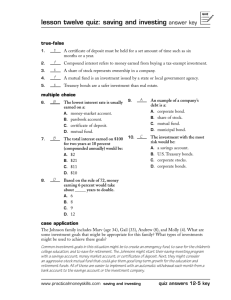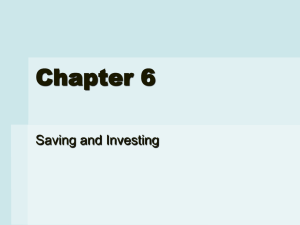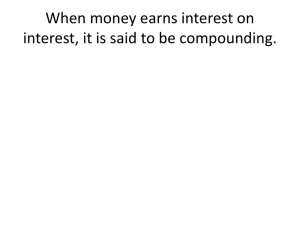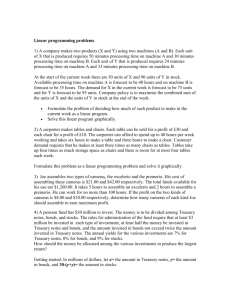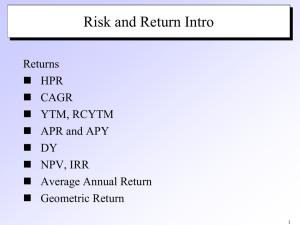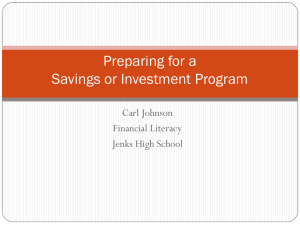Pay-Yourself-First - Edgar County Bank and Trust Co.
advertisement
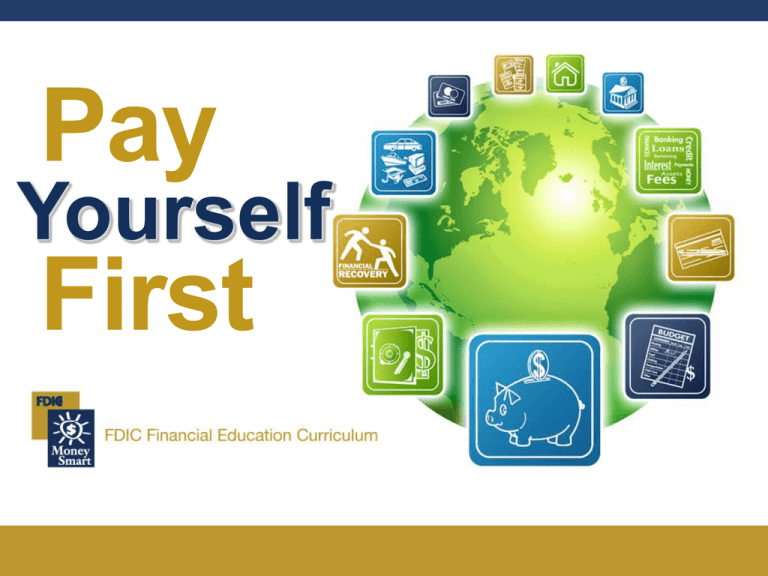
Pay Yourself First Welcome 1. Agenda 2. Ground Rules 3. Introductions Pay Yourself First 2 Objectives • • • • Explain why it is important to save Determine goals for saving money Identify savings options Determine which savings options will help you reach your savings goals • Recognize which investment options are right for you • List ways to save for retirement • List ways to save for large expense goals Pay Yourself First 3 What Do You Know? What do you know or want to learn about saving money? Pay Yourself First 4 Pay Yourself First • What does it mean to “pay yourself first”? • Put money in savings before paying your bills • Why would you want to save money before paying your bills? • What are some of the things you might want to save money for? Pay Yourself First 5 Activity 1: Pay Yourself First Worksheet Complete Statement 1 of Activity 1 in the Participant Guide. 1. Think about savings goals and the amount you need to save. 2. Fill out the first part of the worksheet, “My savings goals.” Pay Yourself First 6 Activity 1: Pay Yourself First Worksheet Complete Statement 2 of Activity 1 in the Participant Guide. 1. Consider the savings tips you just learned about. 2. Fill out the second part of the worksheet, “Strategies to save for my goals.” Pay Yourself First 7 Interest Interest is: • An amount of money financial institutions pay you for keeping money on deposit with them • Expressed as a percentage • Calculated based on the money in your account Pay Yourself First 8 Compound Interest • You earn money on: • Previously paid interest • The money in your account • Interest can be compounded: • Daily • Monthly • Annually Pay Yourself First 9 Annual Percentage Yield (APY) APY: • Is the amount of interest you will earn on a yearly basis expressed as a percentage • Includes the effect of compounding • Should be used to compare saving products, not the interest rate Pay Yourself First 10 Rule of 72 A formula that lets you estimate: • How long it will take for your savings to double in value: 72 ÷ 4% = 18 years • The interest rate needed to double your savings within a set time period: 72 ÷ 12 = 6% • If you want your savings account to double in value in 20 years, what interest rate would the account need to have? • 72 ÷ 20 = 3.6% Pay Yourself First 11 Saving Options • There are two basic ways to save money: 1. Open a savings account –Federally insured by the Federal Deposit Insurance Corporation (FDIC) –www.myfdicinsurance.gov 2. Invest your money –Not federally insured and can lose value Pay Yourself First 12 Name the Savings Product Money Market Account Certificate of Deposit Statement Savings Account 1. An account in which you: • • • • Leave your money for a set period of time/term Cannot make deposits or withdrawals Earn a higher interest rate with longer terms Pay a fee if you withdraw your money before the term has ended Pay Yourself First 13 Name the Savings Product Money Market Account Certificate of Deposit Statement Savings Account 2. An account that: • Requires a higher minimum balance to earn interest (usually) • Pays a higher interest rate for higher balances • Does not have a fixed term • Allows you to make deposits and withdrawals Pay Yourself First 14 Name the Savings Product Money Market Account Certificate of Deposit Statement Savings Account 3. An account that: • Pays interest on your balance • May require you to maintain a minimum daily balance • Requires a lower minimum deposit to open Pay Yourself First 15 Individual Development Account (IDA) • Matched savings accounts • Helps low-income families save money and become financially independent • Uses: • • • • Job training College education Small business start up Home purchase Pay Yourself First 16 Electronic Transfer Account (ETA) • Low-cost account • Allows federal payment recipients to receive their payments through direct deposit • Features include: • Monthly fee of $3 (or less) • No minimum balance • Debit card for point-of-sale transactions may be offered Pay Yourself First 17 529 College Savings Plan • Education savings plan: • Operated by a state or educational institution • Designed to help families set aside funds to pay for future college costs • Types: • 529 Prepaid Tuition Plan • 529 Savings Plan Pay Yourself First 18 Buy an Investment • Investment: a long-term savings option for future income or financial benefit • Investment products are not federally insured. • You must weigh the risks and returns. • You earn money by: • Selling the investments for more than you paid • Receiving dividends and interest earnings Pay Yourself First 19 Before You Invest • Save money (6-month savings cushion) • Talk to: • Your bank • A reputable financial advisor • An investment firm • Ask about employer-offered retirement accounts • Do your own research Pay Yourself First 20 Investment Products • Bonds • Mutual funds • Retirement investments • Stocks • United States (U.S.) Treasury securities Pay Yourself First 21 Name the Investment Product Bonds Mutual funds Retirement investments Stocks U.S. Treasury securities 1. When you loan money to a corporation or the government for a certain period of time/term. 2. When you own a share/part of a company. You might receive periodic dividends when the company makes a profit. Pay Yourself First 22 Name the Investment Product Bonds Mutual funds Retirement investments Stocks U.S. Treasury securities 3. When you loan money to the government. You can select from products based on their face value and maturity date. 4. When you invest money over a long period of time so that you will have money to live on when you are no longer working. Pay Yourself First 23 Name the Investment Product Bonds Mutual funds Retirement investments Stocks U.S. Treasury securities 5. A product that allows you to invest in many investors and investment products. Pay Yourself First 24 Savings Bonds • I Bonds • Purchased at face value • EE Bonds • Normally purchased at half their face value Sample EE Bond Pay Yourself First 25 U.S. Treasury Securities • Treasury (T) bills • Treasury (T) notes • Treasury Inflation-Protected Securities (TIPS) • Treasury (T) Bonds • These are safe because they are backed by the U.S. Government. Pay Yourself First 26 Corporate Bonds • Loans to a corporation for a certain period of time/term • The corporation promises to repay the amount of money you lend it on a specified date. Pay Yourself First 27 Stocks • You: • Own a share/part of a company • May receive dividends if the company profits • The value of your investment changes (up or down) according to the stock market. Pay Yourself First 28 Mutual Funds • A product that: • • • • Combines money from many investors Includes stocks and bonds May pay dividends Changes in value with the stock market • Diversify: spread your risk of loss across many savings and investment options Pay Yourself First 29 Individual Retirement Arrangements (IRAs) • May include a combination of investment products • Are tax exempt • Fluctuate with stock market • Include Traditional IRAs and Roth IRAs Pay Yourself First 30 401(k) and 403(b) Plans • 401(k): • Established by an employer: • You designate a percentage of your pay to be taken out before taxes. • Employers may offer matching contributions. • 403(b): • Offered to employees of public schools and certain tax-exempt organizations Pay Yourself First 31 Variable Annuities • An insurance contract that invests your premium in various mutual fund-like investments • Variable annuities can be very costly due to the fees, which include: • High annual fees • Surrender charges on early withdrawals • Tax penalty on early withdrawal before age 59½ • Life benefit guarantee fee Pay Yourself First 32 How To Choose the Best Investment • Learn as much as possible • Consider how long you plan to keep your money in the investment • Diversify • Re-evaluate your products periodically • Determine your risk tolerance Pay Yourself First 33 Other Investments • Owning a home Value of home Minus Debt Equity = $250,000 = $200,000 = $50,000 • Owning a business Pay Yourself First 34 Saving for Retirement • Make the most of your remaining paychecks until retirement • Try to reduce or eliminate debt • Develop a plan to stretch your money through retirement Pay Yourself First 35 Decision Factors • How much money do you want to save over time? • How long can you leave your money invested? • How do you feel about risking your money? Pay Yourself First 36 Activity 2: Pay Yourself First Action Plan Complete Activity 2 in the Participant Guide. 1. Determine what factors may affect your savings decision making. 2. Determine what short- and long-term actions you can take to save. Pay Yourself First 37 Summary • What final questions do you have? • What have you learned? • How would you evaluate the training? Pay Yourself First 38 Conclusion • You learned: • What it means to pay yourself first and how you can benefit by doing it • Tips to help you save more • How your money can grow with compound interest • A number of savings and investment options • How to decide what savings and investment options are best for you Pay Yourself First 39
